 Roger was the name given to the white lead, drawing by Piffard
Roger was the name given to the white lead, drawing by Piffard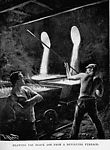 Alkali worker drawing ash from the furnace, drawing by Piffard
Alkali worker drawing ash from the furnace, drawing by Piffard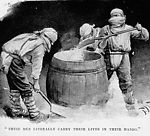 Alkali workers, drawing by Piffard
Alkali workers, drawing by Piffard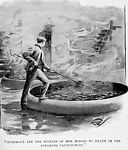 Alkali worker stirring caustic-pots, drawing by Piffard
Alkali worker stirring caustic-pots, drawing by Piffard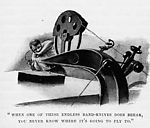 A band-knife used in the shoe-making process, drawing by Piffard
A band-knife used in the shoe-making process, drawing by Piffard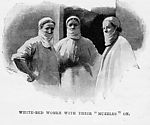 Lead workers, drawing by Piffard
Lead workers, drawing by Piffard Blue-bed women with trucks of lead, drawing by Piffard
Blue-bed women with trucks of lead, drawing by Piffard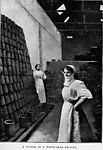 Interior of white lead factory, drawing by Piffard
Interior of white lead factory, drawing by Piffard Early death was common amongst lead workers, drawing by Piffard
Early death was common amongst lead workers, drawing by Piffard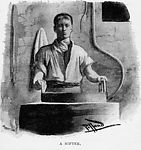 Woolcomber, drawing by Piffard
Woolcomber, drawing by Piffard Poor conditions have taken their toll on this woolcomber, drawing by Piffard
Poor conditions have taken their toll on this woolcomber, drawing by Piffard

Sweated factory work was different from sweated home-work in that no middlemen were involved, but was similarly subject to long hours and low pay in poor and often dangerous conditions. Industries identified as being subject to sweating in the workplace included factories, docks, offices and shops, laundries and work on farms, the roads, railways, canals and at sea. They included the hollow-ware industry, the production of bricks, pickles, confectionery, cutlery,jute and matches. Sweated labour was widespread throughout Britain.
The drawings reproduced here, were done by Harold Piffard, and record the conditions of alkali workers, lead workers, shoemakers and woolcombers . Lives were cut tragically short in many industries. The alkali workers of St Helens risked being poisoned by chlorine gas or boiled alive in caustic vats. The woolcombers of Bradford had their lungs filled with dust that would eventually kill them, and the lead workers of Newcastle were slowly, but surely, poisoned.
In a number of industries employers would insist on the workforce attending at the factory to wait for work to come in, during which time they would not be paid. They might sit there all day waiting for an order to come in, only to be sent home without pay. Other employers would promise a particular piecework rate for an item, and when the workers arrived to do the job, the rate would be dropped, leaving workers little option but to accept it.
How did the employers manage to get away with it? The Factory Acts had set minimum standards and brought in a system of inspection, but the authorities were often slow to accept the dangerous nature of many industries. Also, many workers were afraid to speak out, partly through fear of losing their jobs, and partly for fear of destroying an industry they depended on for a living. The Trade Union movement eventually enabled workers to receive a fair wage, but at the end of the Victorian age, unions were only just gaining strength, and they too had to battle against corruption and intimidation.
It would be re-assuring to think that sweating, low pay and poor conditions, had come to an end. Unfortunately, as we saw from the loss of life amongst the cockle pickers of Morecambe Bay, to some extent it continues today. And all those dangerous industries? Many are now located in the developing world, where Health and Safety legislation has yet to arrive.
Rollover the captions in the box to see the available images in thumbnail format, click the caption to see the full-size image
| Reference: | 728 |
| Keywords: | |
| Archive Ref: | |
| Updated: | Wed 25 Jun 2008 - 1 |
| Interpretation written by | Louis Howe |
| Author's organisation | Curatorial |
| Organisation's website |